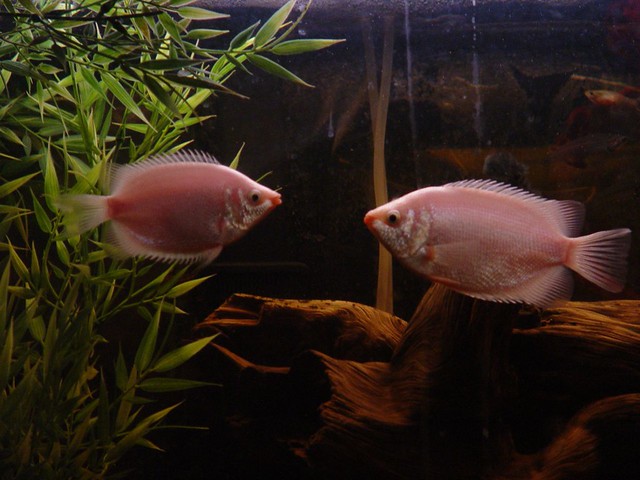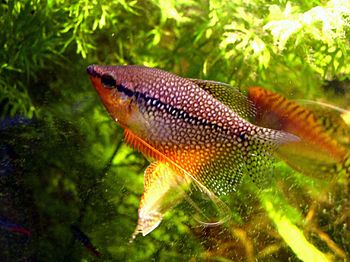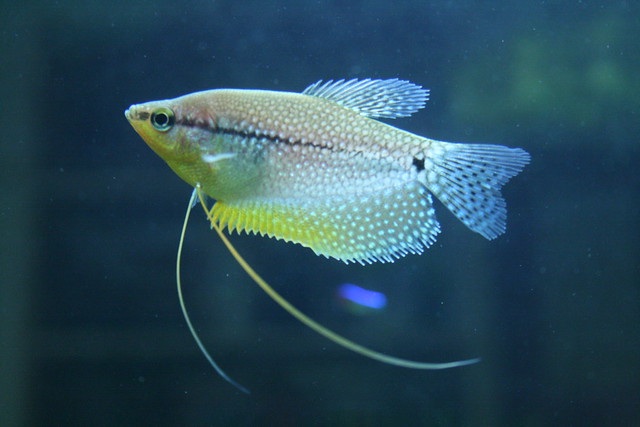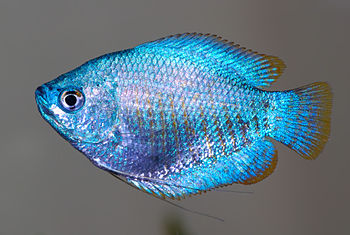Kissing Gourami fish are also called Kisser fish. They are freshwater fish, originated from Thailand and Indonesia. In fact they are the food of people staying in that region.
Kissing Gouramis can be called typical Gourami fish because of their shape. Their body is compressed and elongated. Their fins are also large and elongated. It is very difficult to distinguish between a male and a female.
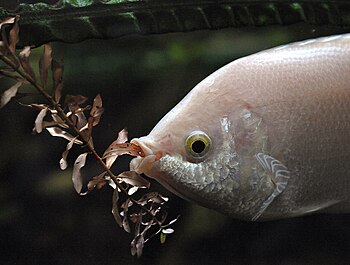 |
| Helostoma temminkii in an aquarium. (Photo credit: Wikipedia) |
They can grow up to 12 inches in length. The unique feature of kissing Gouramis is their mouth. Their lips are thicker and they are lined with teeth.
They love to live in shallow waters which are slow moving. In their natural habitat, they live in a place which is heavily planted. They will eat algae and they will also eat most of the other plants in the water.
They can tolerate a wide variety of conditions. The temperature of water may be in the range of 75-85° F while the ph level may be in the range of 6.5 to 8.5.
Their name comes from their peculiar habit. When two males meet, they will face each other and press their mouth. Due to this action, they are called Kissing Gourami. Some fish keepers call them talking Gourami. These kisses are not harmful but sometimes because of continuous bullying they can develop stress and may even die.
However, experience has shown that as they grow older, their habit of challenging or combating with each other reduces and most of the time they start living peacefully with others.
Like most of the types of Gourami fish, they can come to the surface of the water and can gulp air directly from the atmosphere. This is possible because they have labyrinth organ. Naturally they can survive in the water having low levels of oxygen.
If you want to keep them, you should always plan for a large aquarium having capacity of 80 gallons of water or more. You should also provide some in edible plants as well as some artificial plants because they will try to eat every plant present in the aquarium!
Kissing Gouramis can take wide range of foods including live food well as flaked food and vegetables. You should also feed them with vegetables like spinach or lettuce and peas.
As it is hard to find out the sex of the fish, it is better to buy a group of about 8 to 10 and then allow them to pair up. They will not build any nest but they can spawn a large number of eggs. Normally they will lay up to 12,000 eggs per spawning. These eggs will float on the surface of the water and they will stick to the available surface like plant leaves or plant stems. Some experienced fish-keepers put a leaf of lettuce in the tank which will float and the eggs will be attached to it. After some time, it will also develop fungus which will be used by the fry as their food.
While arranging substrate for the aquarium, you should use large gravel and stones because the fish will try to dig the substrate most of the times as a habit.
In short, if you can provide a big tank with a huge surface area, plenty of plants, reasonably warm water and a compatible combination of species in the aquarium, you can entertain your family members and your guests with the unusual habit of Kissing Gouramis.
Chintamani Abhyankar is a goldfish enthusiast and has been raising and breeding goldfish for many years. He is an expert on their care and an advocate for raising healthy goldfish the natural way.
Article Source: EzineArticles |

